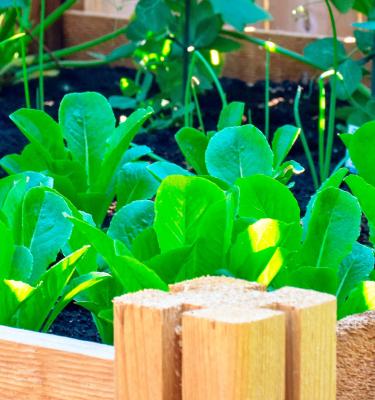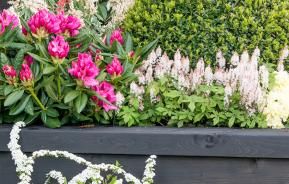What is square foot gardening?
Square Foot Gardening (SFG), as the name suggests, involves building raised beds consisting of multiple square-shaped plots typically 4’x4’ and 6-12 inches deep in which to plant a variety of crops. The phrase ‘square foot gardening’ was originally coined by author Mel Bartholomew in his 1981 All New Square Foot Gardening. Bartholomew deemed traditional gardening inefficient and believed that gardeners were spending hours weeding the gaps between lengthy crop rows and thus wasting large periods of time. Now, Bartholomew’s work continues through The Square Foot Garden Foundation which promotes the method around the world.
Typically raised beds are used in SFG because of their associated benefits –particularly relating of quality of compost. Therefore gardeners who suffer from poor soil conditions can still successfully plant a variety of plants using the raised bed SFG approach. SFG is well suited for beginner gardeners as it allows for experimentation with different plants in a single location. It is also suited to gardeners with small amounts of space to work with, minimum time, and even restricted mobility. It is perfect for those who are looking to create an easy to maintain the garden.
What are the benefits and perks of square foot gardening?
There are a number of reasons why SFG is still going strong thirty years on. Quite simply, the SFG method is easy to manage and maintain, for example, as each square belongs to each crop, there is no plant spacing to remember and fewer seeds are needed. The system provides an easy way to space and rotate crops. It is adaptable and successfully produces high yields of quality produce. Quite simply, SFG eliminates the inefficiency found in traditional methods.
As well as the perks of managing your garden as a gardener, there are a number of benefits to the crop quality. We touched on the fact SFG creates vast, strong yields and this is a result of a number of factors. For example, densely planted plants and crops can prevent weeds from establishing and from germinating. Also, by planting a large variety of crops in a small place plant diseases can be prevented from spreading easily. While, raised beds are the building blocks to SFG and they enable easy to reach into the middle of this dimension, without effort and without causing damage to the soil, as walking on the plot surface risks compacting the soil and reducing drainage.
SFG claims to produce more yield, use less soil and water and take just two per cent of the time spent on a traditional garden and 20 per cent of the space. To sum up, SFG grows more using less.
How to create your own square foot garden
Firstly you will need to consider the space you have to work with and then pick a suitable location in a lot of light. It does not matter if you are building on grass, soil or concrete as the foundation is not particularly important. It is more important that you use appropriate structures, and well-drained, nutrient-rich soil. You can make the creation of your square foot garden a great deal easier by getting a ready-made kit for raised beds. Of course, if you decide to go with this option you will still need to dive the bed into square feet. A 1m x 1m bed will divide into 9 square foot gardens.
Build your structures and then go on to plant your seedlings in each plot. Each square should have either 1, 4, 9, or 16 plants within it depending on the size of the plants. Bartholomew advises in his book to space seeds with care, as opposed to planting the entire seed packet so that plants grow fewer but stronger - we advise (generally) using two or three seedlings. However, consider the size of each plant species when deciding how many to plant – for example, a tomato plant may fill an entire square to itself, while a strawberry plant may fit four per square. Thinning out is also simpler – you just need to cut out the weaker shoots, this way you won’t disturb the roots of the stronger seedlings.
Once you have finished the physical construction of the square foot gardens you need to fill each square with the appropriate bedding. There are a number of different mixtures you can have for your soil, which may have their own preferences. The basic necessity is to have some light and crumbly soil which you may need to add organic matter to encourage growth. There is a range of manures, composts and fertilizers which can improve the soil.
By using a different plant species per square – a variety of crops are encouraged, perfect for the experimentalists amongst us. When picking which plants to grow and where consider planting tall or climbing species in a northern row. By doing so you prevent taller species shading other plants and restricting their growth. It is a good idea to support these taller plants with netting. Peas and beans, for example, should be placed at the back against a structure, or alternatively netting can be placed above the crop to help plants such as tomatoes grow and climb.
Our tips: Covering beds with covers or cages help protect crops from pests, frost, or the sun, while a plastic cover can help during poor weather (placed over dome support). Secondly, companion gardening works as a natural insect repellent. To do this, plant naturally-repellent plants in your crops - these become more effective in closed spaces. Furthermore, a cage made out of chicken wire will protect from curious pets as well as larger pests such as squirrels or birds.
The restrictions of square foot gardening
Arguably the main problem with SFG is that it is easy to outgrow. Many crops can be successfully grown using this method, however larger plants such as main crop potatoes and squash can be less easy to accommodate. A second restriction may be that although raised beds for SFG are affordable to maintain, they can be expensive to set up originally if you have a large area that you want to fill in a short space of time. However, gradually building up your SFG helps to spread the cost.








